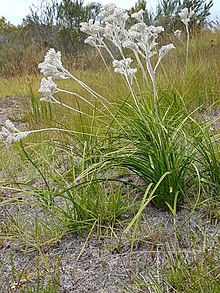
Ceratophyllaceae is a cosmopolitan family of flowering plants including one living genus commonly found in ponds, marshes, and quiet streams in tropical and in temperate regions. It is the only extant family in the order Ceratophyllales. Species are commonly called coontails or hornworts, although hornwort is also used for unrelated plants of the division Anthocerotophyta.

Berberidopsidales is an order of Southern Hemisphere woody flowering plants. The name is newly accepted in the APG III system of plant taxonomy. APG II system, of 2003, mentions the possibility of recognizing the order, as comprising the families Berberidopsidaceae and Aextoxicaceae. However, APG II left the families unplaced as to order, assigning them to the clade core eudicots. The APG III system of 2009 formally recognized the order.

Petrosaviaceae is a family of flowering plants belonging to a monotypic order, Petrosaviales. Petrosaviales are monocots, and are grouped within the lilioid monocots. Petrosaviales are a very small order of photosynthetic (Japonolirion) and rare leafless achlorophyllous, mycoheterotrophic plants (Petrosavia) found in dark montane rainforests in Japan, China, Southeast Asia and Borneo. They are characterised by having bracteate racemes, pedicellate flowers, six persistent tepals, septal nectaries, three almost distinct carpels, simultaneous microsporogenesis, monosulcate pollen, and follicular fruit.

The Penaeaceae are a family of evergreen, leathery-leaved shrubs and small trees, native to South Africa. The family has 29 species in 9 genera. The family Penaeaceae was expanded under the APG III system of classification with the inclusion of the genera Olinia and the single species from the genus Rhynchocalyx.

Asphodelaceae is a family of flowering plants in the order Asparagales. Such a family has been recognized by most taxonomists, but the circumscription has varied widely. In its current circumscription in the APG IV system, it includes about 40 genera and 900 known species. The type genus is Asphodelus.

Gelsemiaceae is a family of flowering plants, belonging to the order Gentianales. The family contains only three genera: Gelsemium, Mostuea and Pteleocarpa. Gelsemium has three species, one native to Southeast Asia and southern China and two native to Central America, Mexico, and the southeastern United States. The eight species of Mostuea are native to tropical areas of South America, Africa, and Madagascar. The two genera were formerly classified in the family Loganiaceae. Pteleocarpa was originally placed in Boraginaceae or in its own family Pteleocarpaceae, but it is most closely related to Gelsemiaceae with which it shares significant characters.

In the APG IV system (2016) for the classification of flowering plants, the name asterids denotes a clade. Asterids is the largest group of flowering plants, with more than 80,000 species, about a third of the total flowering plant species. Well-known plants in this clade include the common daisy, forget-me-nots, nightshades, the common sunflower, petunias, yacon, morning glory, sweet potato, coffee, lavender, lilac, olive, jasmine, honeysuckle, ash tree, teak, snapdragon, sesame, psyllium, garden sage, table herbs such as mint, basil, and rosemary, and rainforest trees such as Brazil nut.
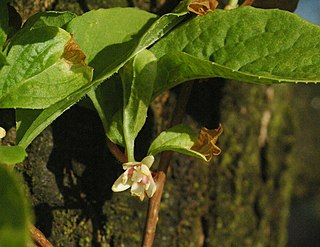
Schisandraceae is a family of flowering plants with 3 known genera and a total of 92 known species. Such a family has been recognized by most taxonomists, at least for the past several decades. Before that, the plants concerned were assigned to family Magnoliaceae and Illiciaceae.
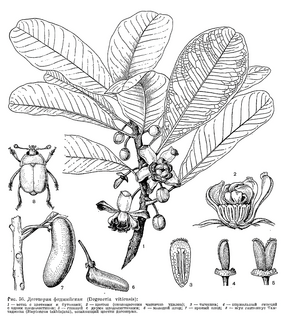
Degeneria is a genus of flowering plants endemic to Fiji. It is the only genus in the family Degeneriaceae. The APG IV system of 2016, recognizes this family, and assigns it to the order Magnoliales in the clade magnoliids.

The Grubbiaceae are a family of flowering plants endemic to the Cape floristic region of South Africa. The family includes five species of leathery-leaved shrubs in two genera, Grubbia and Strobilocarpus. They are commonly known as sillyberry.

Hanguana is a genus of flowering plants with a dozen known species. It is the only genus in the family Hanguanaceae.

Ixiolirion is a genus of flowering plants native to central and southwest Asia, first described as a genus in 1821. Recent classifications place the group in the monogeneric family Ixioliriaceae in the order Asparagales of the monocots. In earlier systems of classification, it was usually placed in the family Amaryllidaceae.

Doryanthes is the sole genus in the flowering plant family Doryanthaceae. The genus consists of two species, D. excelsa and D. palmeri, both endemic natives of the coast of Eastern Australia. Doryanthaceae is part of the order Asparagales.
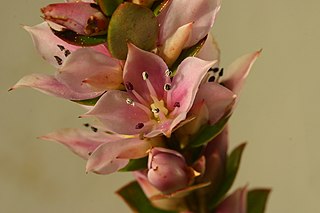
Geissoloma is a genus of flowering plants in the monotypic family Geissolomataceae, native to the Cape Province of South Africa. The plants are xerophytic evergreen shrubs and are known to accumulate aluminum. It is sometimes called guyalone in English.

Tetilla is a genus of flowering plants. It belongs to the family Francoaceae, which is sometimes included as part of the family Melianthaceae. It has historically been included in the Saxifragaceae.
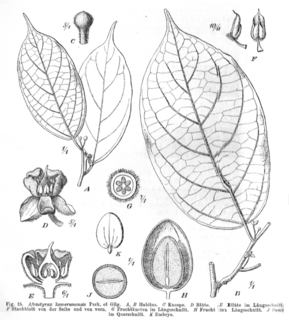
Huaceae is a family of plant in the rosids group, which has been classed in the orders Malpighiales, Malvales, and Violales or in its own order Huales. The APG II system placed it in the clade eurosids I, whereas the APG III system of 2009 and APG IV (2016) place it within the Oxalidales. The family is endemic to central Africa. It contains four species in the following two genera:
Hondurodendron is a monotypic genus of tree endemic to Honduras. The only species in the genus, H. urceolatum, was discovered during 2004 and 2006 botanical surveys of plants in Parque Nacional El Cusuco in northwest Honduras. It was subsequently described in 2010 by Carmen Ulloa Ulloa, Daniel L. Nickrent, Caroline Whitefoord, and Daniel L. Kelly in the Annals of the Missouri Botanical Garden.

Maundia is a genus of alismatid monocots, described in 1858. Maundia was formerly included in the family Juncaginaceae but is now considered to form a family of its own under the name Maundiaceae. It contains only one known species, Maundia triglochinoides, endemic to Australia.

Alismatid monocots is an informal name for a group of early branching monocots, consisting of two orders, the Acorales and Alismatales. The name has also been used to refer to the Alismatales alone. Monocots are frequently treated as three informal groupings based on their branching from ancestral monocots and shared characteristics: alismatid monocots, lilioid monocots and commelinid monocots. Research at the Royal Botanical Gardens, Kew is organised into two teams I: Alismatids and Lilioids and II: Commelinids. A similar approach is taken by Judd in his Plant systematics.

Harmandia mekongensis is a species of flowering plants. It is the only species in the monotypic genus of Harmandia. In the APG IV system, the genus is placed in the family Olacaceae. Other sources place it in the segregate family Aptandraceae.
